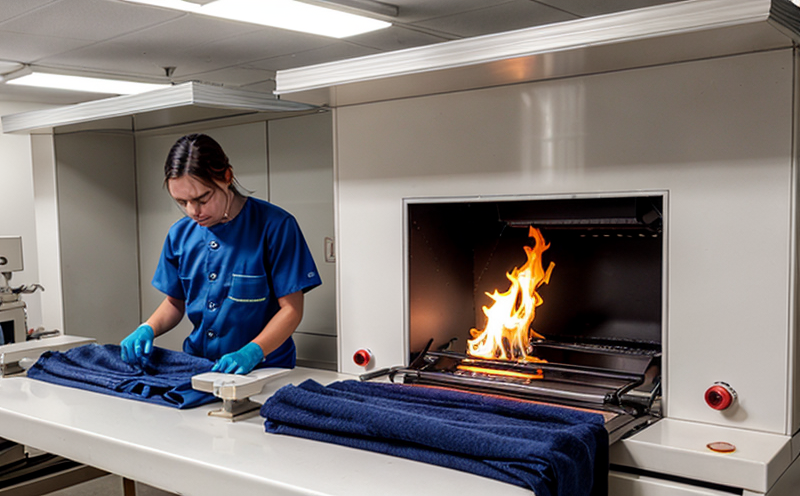EN 14878 Flame Retardant Properties of Textiles – Linting and Burning Behavior
The European Standard EN 14878 specifies the methods for assessing the flame retardant properties of textiles with respect to linting and burning behavior. This standard is particularly relevant in sectors where fabric exposure to flames or high temperatures may occur, such as automotive interiors, furniture upholstery, and industrial garments.
Linting refers to the process by which small fibers detach from a material surface and become airborne. Burning behavior encompasses the manner in which textiles ignite under specific conditions, including the rate of ignition, flame spread, and residual char formation. Flame retardant properties are crucial for ensuring that fabrics remain safe when exposed to fire or high heat sources.
Flame retardants are chemicals added to materials to reduce their tendency to burn. They can be applied through various methods including impregnation, padding, and coating. The effectiveness of these treatments is evaluated using standardized testing procedures outlined in EN 14878. These tests assess both the physical properties (such as linting) and chemical properties (such as flame spread rate).
Properly treated textiles not only comply with regulatory requirements but also enhance occupant safety by reducing the risk of injury or death from fires. Compliance with EN 14878 ensures that products meet rigorous standards, thereby gaining consumer trust and meeting international market demands.
The testing process involves carefully preparing specimens according to specified dimensions and conditions. Specimens are then subjected to controlled burn tests where their behavior under different ignition sources is observed and recorded. Linting is measured by collecting airborne fibers during the test and quantifying them using gravimetric methods or other suitable techniques.
| Test Parameter | Description |
|---|---|
| Linting | Measurement of fibers released into air during ignition. |
| Burning Behavior | Observation and quantification of flame spread rate, duration, and char formation. |
| Flame Retardancy | Evaluation of the effectiveness of flame retardants used in the fabric. |
The results from these tests provide valuable insights into the performance characteristics of textiles under various conditions. Understanding these parameters helps manufacturers optimize their product designs for better safety and durability while adhering to stringent international standards.
- EN 14878 is widely recognized by regulatory bodies across Europe.
- The United States has equivalent standards such as ASTM D6230.
- Asian countries often adopt similar protocols for comparable products.
In conclusion, EN 14878 plays a pivotal role in ensuring the safety of textiles exposed to fire hazards. By adhering to this standard, manufacturers can produce safer products that meet regulatory requirements and enhance consumer confidence.
Scope and Methodology
| Method | Description |
|---|---|
| Linting Test | The specimen is placed on a metal grid in a test chamber. A flame is applied, and the amount of lint released into the air is measured. |
| Burning Behavior Test | A controlled flame is applied to the specimen. The duration and spread rate of the flame are recorded. |
| Flame Retardancy Assessment | The effectiveness of flame retardants used in the fabric is evaluated by comparing pre- and post-test results. |
The methodology for EN 14878 involves several key steps. First, the textile specimens must be prepared according to specified dimensions and conditions. This ensures uniformity across all samples being tested. Next, the specimens are exposed to controlled burn tests using standardized ignition sources. During these tests, various parameters such as linting, burning behavior, and flame retardancy are carefully measured and recorded.
The testing process is designed to simulate real-world scenarios where textiles might encounter fire hazards. By subjecting materials to these conditions, we can accurately assess their performance characteristics and identify any areas for improvement.
It’s important to note that the results from these tests provide valuable insights into the safety of textiles under different conditions. Understanding these parameters helps manufacturers optimize their product designs for better safety and durability while adhering to stringent international standards.
Quality and Reliability Assurance
The quality and reliability of EN 14878 testing are ensured through strict adherence to the standard’s procedures. Laboratories that conduct these tests undergo rigorous accreditation processes, ensuring they meet high-quality standards set by recognized bodies such as ISO/IEC 17025.
Accreditation ensures that laboratories have the necessary expertise, facilities, and equipment to perform accurate and reliable tests. Regular audits and reviews are conducted to maintain compliance with international best practices. This continuous improvement process helps ensure consistent and repeatable results across multiple testing sessions.
Quality assurance measures also include strict control over specimen preparation, calibration of instruments used in the test, and adherence to standardized procedures throughout the entire testing process. By maintaining these high standards, laboratories can provide accurate and reliable data that supports informed decision-making by manufacturers and regulatory bodies.
The reliability of EN 14878 testing is further enhanced through inter-laboratory comparisons. These exercises involve multiple laboratories performing the same tests on identical specimens to ensure consistency in results. Any discrepancies are investigated, ensuring that any issues are addressed promptly.
International Acceptance and Recognition
- The European Union has adopted EN 14878 as a harmonized standard for textiles.
- The United States recognizes ASTM D6230 as an equivalent standard to EN 14878.
- Australia uses AS/NZS 5129, which aligns closely with the European and American standards.
- Many Asian countries have adapted similar protocols for comparable products.
The widespread acceptance of these standards reflects their importance in ensuring safety across various industries. By adopting EN 14878 or its equivalents, manufacturers can ensure that their products meet stringent safety requirements while also meeting international market demands.





